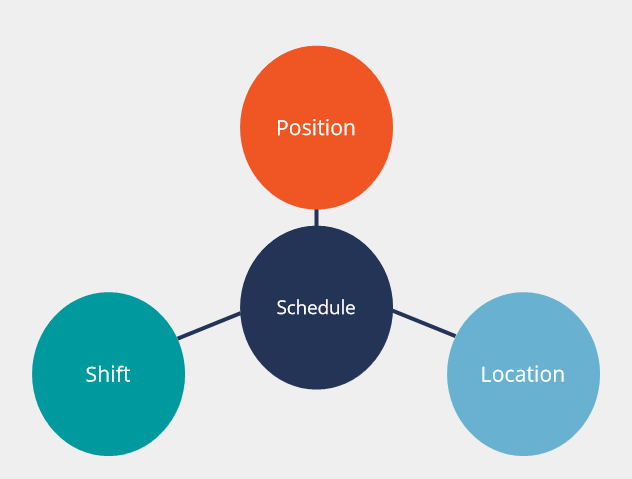Building Blocks of a Schedule
SchedulePro Building Blocks will give you an overview of SchedulePro's 4 Key Elements and 3 Core Codes. These work together to generate your workforce schedule.
Key Elements
4 Key Elements: (1) Codes, (2) Requirements, (3) Employees, (4) Shift Patterns
- Codes: Codes are short, descriptive labels that define key elements within your organization's workforce scheduling (eg. types of positions, various shifts used)
- Requirements: Staffing requirements specify how many of a particular type of employee (position) is required for a specific location and shift. They are defined by a position, location and shift code, and then the number of employees required each day of the week.
- Employees: Every employee is assigned a primary position code and location code. This identifies their main job of work (position) and physical area of work (location). These two codes tells SchedulePro who is qualified to work which staffing requirement. Employees can also have secondary position and location codes.
- Shift Patterns: A shift pattern is fancy term for an employee's standard schedule. If your employees work on a cyclical schedule, shift patterns come in handy as they are templates that ensure your employees are working their usual shift each day of the week.
Codes
Each cell in a schedule is made up of 3 key pieces of information (code triplet). The naming of the codes can vary from organization to organization, but the code triplet is a combination of a Position code, a Job/Location code and a Shift code. Together these drive the schedule.
- Shift Codes: Shift codes define the various shifts used in your organization. Think about this as the "when" is someone scheduled to work.
- Position Codes: Position codes represent the various jobs your employees may perform. They tell you the role that an employee will be performing, while on-shift. Think about this as the "what" is someone scheduled to work.
- Location Code: Location codes simply define the physical location of where employees work. They may denote entirely separate locations such as Regina Branch and Edmonton Branch, or different areas within a single location such as Eastside and Westside. Think about this as the "where" is someone scheduled to work.

Requirements
We also need to determine "how many" of this code combination (or triplet) do you need?
SchedulePro uses Requirements to decide what to do with the triplet codes that are created. If the code triplet is a building block, the requirement is the instruction manual.
"I need 1 (one) | technician | on the Main Console | during the day shift." |
How many? | What? | Where? | When? |
Quantity | Position Code | Job/Location Code | Shift Code |
These requirements are used to define how many employees need to be scheduled each day of the week, the shift they are assigned and where.
Using these 4 items, you can build your schedule and populate it. When you're finished, your schedule view will look something like this:

